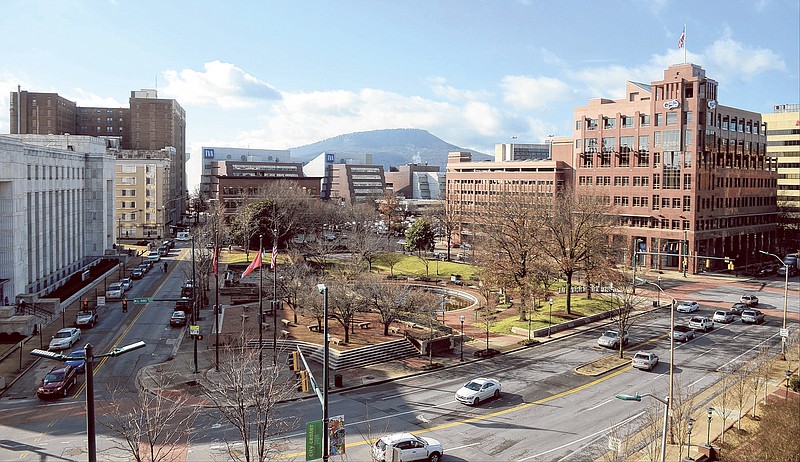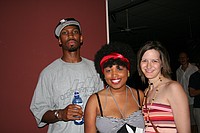Photo Gallery
Hip-Hop School graduation
The first graduating class of the Hip-Hop School held a performance at The ArtsScene on Wednesday night.
But the grand theater with its uniformed staff and swooping neon sign is gone. EPB headquarters occupies part of the land where the theater sat at the intersection of M.L. King Boulevard (then known as Ninth Street) and Broad and Market streets.
A couple of blocks down Ninth Street, the posh, 50-room Martin Hotel once was a centerpiece of the area. Guests included baseball greats Willie Mays and Satchel Paige, basketball's original Harlem Globetrotters, singers Lena Horne and Cab Calloway and J. Ernest Wilkins, the U.S. Assistant Secretary of Labor.
"The Martin Hotel was one-of-a-kind and very unique." says Shane Morrow, the organizer of Jazzanooga, the city's annual jazz festival. "During its heyday, it was not just a hotel for African-Americans, but it was a cultural hub of sorts that famous African-American entertainers stayed in when they came to the area for performances."
The Big Nine:
The stretch of Ninth Street between Memo's Grill at the corner of Foster Street and the Peeples Street overpass was lovingly known as the Big Nine and was the city's epicenter of black music, fun, dancing and food from the '30s through the '60s. Dubbed by some as the Harlem of the South, it featured at least six nightclubs that hosted world-famous stars such as Cab Calloway and Chattanooga's own Bessie Smith. Many local black musicians started their careers playing in Big Nine clubs, then moved on to gigs with James Brown, Miles Davis, Aretha Franklin and others. Fred Cash and Sam Gooden, who would later help create R&B vocal group the Impressions with Curtis Mayfield in Chicago, got their start on the Big Nine. Famous black acts such as Muddy Waters, Howlin' Wolf, Ray Charles and Count Basie would visit the clubs after they finished their own gigs at other venues around Chattanooga.
Many landmark black history sites in Chattanooga are likewise gone or unrecognizable; parking lots or new buildings replacing the old edifices or the original buildings simply crumbling down after being abandoned.
"Chattanoogans have never been particularly romantic about our past, so a lot of historic buildings have been torn down," says attorney Maury Nicely, who researched and wrote the "Chattanooga Walking Tour & Historic Guide."
Martin Luther King Jr. interviewed for a job as minister of this church at 506 E. Eighth St., but the church thought he was too young at age 24.
"Historians like to say Charleston (S.C.) had the great benefit of being economically stymied after the Civil War, so neighborhoods were not torn down to make way for development," he says. "Chattanooga was the Dynamo of Dixie; historic buildings were torn down and replaced by roads, highways, parking lots, offices and factories."
Anyone strolling downtown Chattanooga may walk past a patch of ground where black protesters risked their lives for civil rights, or former slaves who fled their plantations camped out under the stars, or the founder of the first black newspaper laid out type.
Former NAACP president James Mapp, who led store boycotts in downtown Chattanooga in the 1960s, declines to discuss sites that had cultural or social significance for the black community.
"Some of that history will be in my book that's coming out in the next couple of months, so I really don't want to talk about it now," Mapp says. He would say, however, that one of his favorite sites is the plaque on Market Street where the S.H. Kress store once stood and Howard High School students protested its segregated lunch counter with a 1960 sit-in.
If you use your imagination, you can imagine what that building, that park or that jail looked like to men and women who gambled everything on making the American dream more of a reality for all Chattanoogans.
Contact staff writer Lynda Edwards at ledwards@timesfreepress.com or 423-757-6391.
The sites
Mahogany Hall: To call John Lovell the black Donald Trump does not begin to describe how big an impact he had on blacks striving for a secure place in this city. The son of a white planter and a black woman, he launched his real estate empire in Chattanooga by pitching a tent during the Civil War at the intersection of Fourth and Market streets and using it as a sort of dry goods store and social hub for soldiers who wanted to meet females euphemistically described as "sporting women." Lovell used the money earned there to build the opulent Mahogany Hall, which once loomed where Miller Park now sits. The three-story building held a hotel, restaurants, saloons, casino, dance hall and an upscale brothel. He invested massively in real estate with his uncle, developer George Lewis, who would then sell the parcels at a fair price to black Chattanoogans wanting to build their first homes in the years right after the Civil War. The Rogers Theater: Bordered by Market and Broad streets and what was then Ninth Street, later renamed M.L. King Boulevard, the Rogers was a true movie palace with uniformed staff, an elegant interior and segregated seating. In 1961, civil rights protesters staged a sit-in to challenge that policy. EPB's headquarters occupies the spot now. The Blade: At the intersection of M.L. King Boulevard and Houston Street sits a beautiful but battered dark-brick building with graffiti scrawled across the plywood barrier that protects the front. It's where Randolph Miller launched The Blade, the first black-owned newspaper in Chattanooga. A plaque honoring Miller was across the street but it has vanished. Market Street protests: At S.H. Kress, a "five-and-dime" store on Market Street, Howard High School students staged a sit-in at the white section of the store's lunch counter on Feb. 19, 1960. The News-Free Press described the nonviolent demand for equal rights as "indecent" bad manners. In the months following the Kress sit-in, other such protests took place at stores on Market between Seventh and Ninth streets, including W.T. Grant, Woolworth's and again at Kress. On Feb. 23, 1960, fire hoses were used to disperse a crowd of peaceful protesters on Market; however, unlike the similar - and famous - use of fire hoses on protesters in Birmingham, Ala., in Chattanooga, the hoses were turned upward so protesters were drenched with the water, not struck by the concrete-like blast from the hoses. Walden Hospital: Located at 528 E. Eighth St., the first black hospital in Chattanooga was founded in 1915. It had 30 beds for patients and 19 black doctors to care for them. The building also served as a nursing school for 55 years. It is now apartments. The Freight Depot: In 1931, nine black teenagers hopped a train at the Freight Depot, located at 1206 Market St., a move that would lead to them ultimately being known as the famous Scottsboro Boys. On the train, the black teenagers encountered a group of white youths who were accompanied by two girls. The two groups of males got into a fight, and the girls later accused the blacks of rape. The defendants' convictions were twice appealed to the U.S. Supreme Court, which returned two landmarks decisions. In the first one, it ordered new trials because the due process guaranteed by the U.S. Constitution includes "effective assistance of counsel," which justices said the defendants did not get. After they were convicted a second time by an all-white jury, the Supreme Court reversed the convictions again because no blacks were included in the jury pool. The accounting firm Henderson Hutcherson & McCullough is now in the Freight Depot building. Pleasant Garden Cemetery: The 17-acre black cemetery on the edge of Ridgeside closed in 1970 but still is beautiful even in disarray. Ed Johnson, the victim of a lynching on the Walnut Street Bridge in 1906, is buried here. Singer Lionel Richie's great-grandfather, Lewis Brown, is there, too, as are Andrew and Leroy Wright, two of the four Chattanoogans involved in the Scottsboro Boys case. Although volunteers have cleaned up some of it over the years, the cemetery is in rough shape with dozens of tumbled tombstones, graves sunken into the ground and undergrowth crowding in around the edges as well as poking up in the graves themselves. Many graves are completely overgrown inside dense thickets. Pleasant Garden is owned by a doctor in Houston who has refused to comment on several occasions when contacted by the Times Free Press. T.C. Thompson home: The gray Victorian home at 212 High St. was the residence of former Chattanooga mayor T.C. Thompson, a businessman who brought a lot of manufacturing to the city. But Thompson survived to adulthood thanks to the compassion of a black Union Army soldier. Thompson was a small boy in Georgia and in the direct path of Gen. Tecumseh Sherman's march through Georgia in 1864. The soldier found Thompson alone and crying, separated from his family. He rescued the boy and took care of him until relatives could be found. The home is now the Bluff View Inn. The Martin Hotel: During the Jim Crow era, the black celebrities who played in clubs along the Big Nine were not welcome in white-owned hotels. So they stayed at the elegant Martin Hotel, located where the Bessie Smith Cultural Center now stands at 200 E. M.L. King Blvd. Renaissance Park: The Emancipation Proclamation freed slaves, but it had no way of protecting them from physical violence once they had their liberty. As the Civil War was ending, the Union Army set up camps that offered a safe sanctuary to free black men and women. One, nicknamed Camp Contraband, was located where Renaissance Park now sits and spread over what is now Hill City, a section of North Chattanooga. The camp was home to about 4,000 men, women and children over several years. The Big Nine: The stretch of Ninth Street between Memo's Grill at the corner of Foster Street and the Peeples Street overpass was lovingly known as the Big Nine and was the city's epicenter of black music, fun, dancing and food from the '30s through the '60s. Dubbed by some as the Harlem of the South, it featured at least six nightclubs that hosted world-famous stars such as Cab Calloway and Chattanooga's own Bessie Smith. Many local black musicians started their careers playing in Big Nine clubs, then moved on to gigs with James Brown, Miles Davis, Aretha Franklin and others. Fred Cash and Sam Gooden, who would later help create R&B vocal group the Impressions with Curtis Mayfield in Chicago, got their start on the Big Nine. Famous black acts such as Muddy Waters, Howlin' Wolf, Ray Charles and Count Basie would visit the clubs after they finished their own gigs at other venues around Chattanooga. TERMINAL STATION: Entrances to the train station on Market Street were segregated before the Civil Rights Era. The Chattanooga Choo Choo hotel is there now. First Baptist Church: Martin Luther King Jr. interviewed for a job as minister of this church at 506 E. Eighth St., but the church thought he was too young at age 24.

